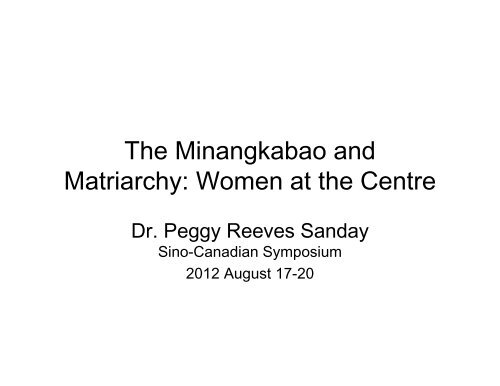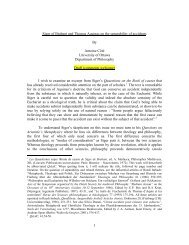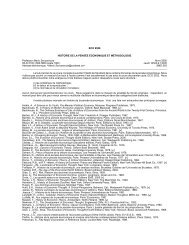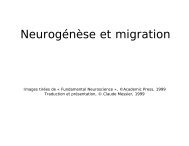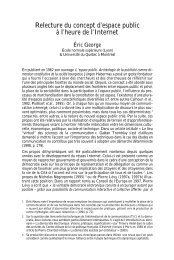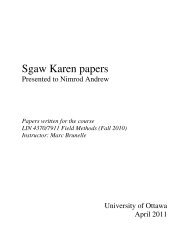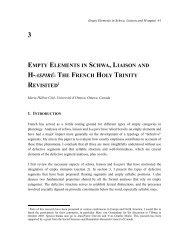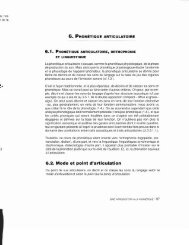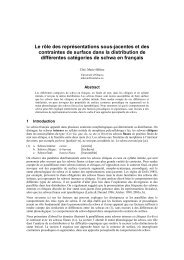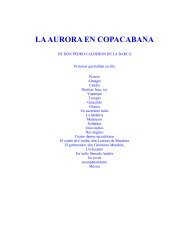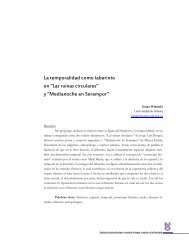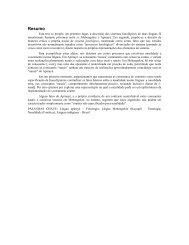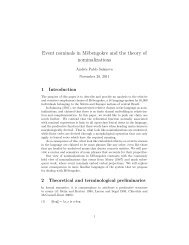Women at the Centre - University of Ottawa
Women at the Centre - University of Ottawa
Women at the Centre - University of Ottawa
You also want an ePaper? Increase the reach of your titles
YUMPU automatically turns print PDFs into web optimized ePapers that Google loves.
The Minangkabao and<br />
M<strong>at</strong>riarchy: <strong>Women</strong> <strong>at</strong> <strong>the</strong> <strong>Centre</strong><br />
Dr. Peggy Reeves Sanday<br />
Sino-Canadian Symposium<br />
2012 August 17-20
M<strong>at</strong>rixial/M<strong>at</strong>riarchal Webs <strong>of</strong> Meaning in<br />
<strong>the</strong> Minangkabau Ritual Calendar<br />
• The Minangkabau <strong>of</strong> West Sum<strong>at</strong>ra,<br />
Indonesia are <strong>the</strong> largest m<strong>at</strong>rilineal society<br />
in today’s world. They are one <strong>of</strong> 300 ethnic<br />
groups in Indonesia, <strong>the</strong> fourth largest,<br />
consisting <strong>of</strong> some 4 million people in <strong>the</strong>ir<br />
homeland <strong>of</strong> West Sum<strong>at</strong>ra and 4 million in<br />
o<strong>the</strong>r parts <strong>of</strong> Indonesia. They refer to <strong>the</strong>ir<br />
ritual and family system as ad<strong>at</strong><br />
Minangkabau or as ad<strong>at</strong> m<strong>at</strong>riarcha<strong>at</strong>.
Indonesia
West Sum<strong>at</strong>ra, Central Sum<strong>at</strong>ra
Mo<strong>the</strong>r as <strong>the</strong> Beginning<br />
• In Minangkabau all beginnings are<br />
granted respect—first ancestress,<br />
mountain <strong>of</strong> origin, original song, or<br />
first village settled in a particular area.<br />
Th<strong>at</strong> which comes first is associ<strong>at</strong>ed<br />
with growth (in n<strong>at</strong>ure) or birth from a<br />
mo<strong>the</strong>r. This privileging <strong>of</strong> mo<strong>the</strong>r<br />
places senior women <strong>at</strong> <strong>the</strong> social,<br />
emotional, aes<strong>the</strong>tic, and economic<br />
center <strong>of</strong> daily and ceremonial life.
Fieldwork in West Sum<strong>at</strong>ra<br />
• For more than 20 years I conducted field research in<br />
West Sum<strong>at</strong>ra beginning in l981 and still ongoing.<br />
For more inform<strong>at</strong>ion, see my book <strong>Women</strong> <strong>at</strong> <strong>the</strong><br />
Center: Life in a Modern M<strong>at</strong>riarchy, Cornell<br />
<strong>University</strong> Press (2002).<br />
• In this book I redefine m<strong>at</strong>riarchy as <strong>the</strong> cultural<br />
elabor<strong>at</strong>ion <strong>of</strong> a symbolic system in which MOTHER<br />
and NURTURE are <strong>the</strong> dominant symbols—as<br />
opposed to power and dominance. My article on this<br />
redefinition appears in <strong>the</strong> recently issued Oxford<br />
Encylopedia <strong>of</strong> <strong>Women</strong> in World History.
MOTHER MEANINGS AND<br />
SYMBOLS<br />
• In Minangkabau parlance all older women are<br />
referred to as Bundo Kanduang, which<br />
means own mo<strong>the</strong>r (or female rel<strong>at</strong>ive in<br />
m<strong>at</strong>rilineal line.) The mythical Queen <strong>of</strong> <strong>the</strong><br />
Minangkabau is called Bundo Kanduang.<br />
The Minangkabau st<strong>at</strong>e myth tells <strong>of</strong> <strong>the</strong><br />
exploits <strong>of</strong> this Queen and her sons who<br />
worked toge<strong>the</strong>r to uphold m<strong>at</strong>rilineal law.<br />
This law—called <strong>the</strong> mo<strong>the</strong>r’s law—gives<br />
m<strong>at</strong>rilineal descent <strong>the</strong> st<strong>at</strong>us <strong>of</strong> divine law.<br />
Men and women work toge<strong>the</strong>r to uphold this<br />
law.
Minangkabau Ethno Philosophy<br />
• Ritual emphasis is always on connection-to<br />
r<strong>at</strong>her than splitting-from <strong>the</strong> mo<strong>the</strong>r (as in<br />
phallic consciousness)<br />
• Mo<strong>the</strong>r here extends to all m<strong>at</strong>rilineal female<br />
kin.<br />
• Males in <strong>the</strong> m<strong>at</strong>rilineal line play an important<br />
legal and teaching role as uncles.<br />
• The role <strong>of</strong> f<strong>at</strong>hers is to help wives, mo<strong>the</strong>rs,<br />
and children.
Growth in N<strong>at</strong>ure is <strong>the</strong> Mimetic Model<br />
• Encounter, connection, and symbols <strong>of</strong> passageway<br />
are based on <strong>the</strong> unfurling and blooming in n<strong>at</strong>ure as<br />
a teacher<br />
• Connecting children to mo<strong>the</strong>r (m<strong>at</strong>rilineal) so th<strong>at</strong><br />
children are never dislodged from <strong>the</strong>ir n<strong>at</strong>al home<br />
• Connecting males to <strong>the</strong>ir family <strong>of</strong> orient<strong>at</strong>ion as<br />
well as to <strong>the</strong>ir family <strong>of</strong> procre<strong>at</strong>ion. The f<strong>at</strong>her<br />
plays two roles—connected to his mo<strong>the</strong>r through<br />
<strong>the</strong> m<strong>at</strong>rilineal system; connected to his children<br />
through <strong>the</strong>ir mo<strong>the</strong>r with whom f<strong>at</strong>hers live in a<br />
m<strong>at</strong>ri-local household.
BUNDO KANDUANG-PROVERB<br />
Bundo Kanduang (our own mo<strong>the</strong>r) is <strong>the</strong><br />
butterfly <strong>of</strong> <strong>the</strong> traditional house<br />
She is <strong>the</strong> one who owns <strong>the</strong> key <strong>of</strong> <strong>the</strong> clo<strong>the</strong>s<br />
chest and <strong>the</strong> jewelry box<br />
She is <strong>the</strong> center where <strong>the</strong> threads <strong>of</strong> <strong>the</strong> fish<br />
net meet<br />
She is <strong>the</strong> finery <strong>of</strong> <strong>the</strong> village<br />
She is sovereign through her dignity<br />
The one who is gre<strong>at</strong>ly honored<br />
The one to whom we take all our problems<br />
The one who receives our last wishes when we<br />
die.
PROVERB--GROWTH IN NATURE IS OUR<br />
TEACHER<br />
Take <strong>the</strong> small knife used for carving<br />
Make a staff from <strong>the</strong> lintabuang tree<br />
The cover <strong>of</strong> pinang flowers becomes a<br />
winnow<br />
A drop <strong>of</strong> w<strong>at</strong>er becomes <strong>the</strong> sea<br />
A fist becomes a mountain<br />
Growth in n<strong>at</strong>ure is our teacher
THE SOCIAL ROLE OF NATURE:<br />
HOUSES FACE SACRED MOUNTAIN
MATRILINEAL HOUSEHOLD
RECONSTRUCTED PALACE OF BUNDO<br />
KANDUANG: TOURIST ATTRACTION
Minang/kabau—VICTORIOUS BUFFALO<br />
• Connection to n<strong>at</strong>ure/nurture is reflected in<br />
story <strong>of</strong> <strong>the</strong> origin <strong>of</strong> <strong>the</strong> Minangkabau<br />
• War between <strong>the</strong> Javanese and <strong>the</strong> people <strong>of</strong><br />
<strong>the</strong> highlands <strong>of</strong> West Sum<strong>at</strong>ra was decided<br />
in a buffalo fight<br />
• The Javanese put forth a huge bull buffalo<br />
• The local people put forth a starved baby<br />
buffalo<br />
• Who won <strong>the</strong> fight? The baby buffalo,<br />
because males protect <strong>the</strong> young and women<br />
nurture life in <strong>the</strong> village. Life cycle<br />
ceremonies domin<strong>at</strong>e village life.
WEDDINGS: KNIT VILLAGE SOCIAL<br />
TIES.BRIDE’S FAMILY COLLECTS<br />
GROOM
King and Queen <strong>at</strong> Marriage
N<strong>at</strong>ure provides <strong>the</strong> coordin<strong>at</strong>es <strong>of</strong><br />
• Examples:<br />
daily living.<br />
• Houses are positioned to face <strong>the</strong><br />
sacred mountains.<br />
• Merging <strong>of</strong> n<strong>at</strong>ure and culture includes<br />
merging Islam, which came to villages<br />
in l9th century, into M<strong>at</strong>rilineal family<br />
compound
Islamic Prayer House in M<strong>at</strong>rilineal<br />
Compound
Male and female work toge<strong>the</strong>r in<br />
different ways<br />
• Symbolically, males are likened to <strong>the</strong><br />
trees th<strong>at</strong> shelter<br />
• <strong>Women</strong> to <strong>the</strong> found<strong>at</strong>ion post <strong>of</strong> <strong>the</strong><br />
m<strong>at</strong>rilineal long house<br />
• Men are likened to <strong>the</strong> fern leaf tendril<br />
• The nurture <strong>of</strong> women is alluded to in<br />
<strong>the</strong> story about <strong>the</strong> buffalo calf who<br />
fought <strong>the</strong> war th<strong>at</strong> gave <strong>the</strong><br />
Minangkabau <strong>the</strong>ir name
How this works in ritual calendar<br />
• <strong>Women</strong> articul<strong>at</strong>e and gener<strong>at</strong>e webs <strong>of</strong> social<br />
connection through life cycle rituals [Birth, marriage,<br />
marriage difficulties, de<strong>at</strong>h]<br />
• <strong>Women</strong> as a group spin, weave, and interconnect<br />
social webs through m<strong>at</strong>erial acts—getting <strong>the</strong><br />
bananas—symbolic <strong>of</strong> <strong>the</strong> males exchanged in <strong>the</strong><br />
wedding ceremony; cooking foods emblem<strong>at</strong>ic <strong>of</strong> a<br />
real/symbolic philosophy <strong>of</strong> cre<strong>at</strong>ion, gener<strong>at</strong>ion,<br />
life, growth; tying <strong>the</strong> webs <strong>of</strong> social connection<br />
through gifts representing <strong>the</strong> connection <strong>of</strong><br />
n<strong>at</strong>ure/culture; male/female;ancestors/spirits;<br />
old/young.
Male View: quote from famous<br />
male leader<br />
• In n<strong>at</strong>ure all th<strong>at</strong> is born into <strong>the</strong> world is born from<br />
<strong>the</strong> mo<strong>the</strong>r, not from <strong>the</strong> f<strong>at</strong>her. F<strong>at</strong>hers are only<br />
known by a confession from <strong>the</strong> mo<strong>the</strong>r. Ad<strong>at</strong><br />
knows th<strong>at</strong> <strong>the</strong> mo<strong>the</strong>r is <strong>the</strong> closest to her children<br />
and is <strong>the</strong>refore more dominant than <strong>the</strong> f<strong>at</strong>her in<br />
establishing <strong>the</strong> character <strong>of</strong> <strong>the</strong> gener<strong>at</strong>ions.<br />
Thus, we must protect women and <strong>the</strong>ir <strong>of</strong>fspring<br />
because <strong>the</strong>y are also weaker than men. Just as<br />
<strong>the</strong> weak becomes <strong>the</strong> strong in n<strong>at</strong>ure, we must<br />
make <strong>the</strong> weaker <strong>the</strong> stronger in human life. If <strong>the</strong><br />
mo<strong>the</strong>r abandons or doesn’t recognize her own<br />
child, ad<strong>at</strong> exists to recognize <strong>the</strong> child’s descent<br />
line and to ensure <strong>the</strong> child’s worldly welfare.
Focus on Connection, Cleft, Growth, and<br />
Nurture in Human and Language Evolution<br />
• S. Hrdy (1999) argues based on evolutionary<br />
d<strong>at</strong>a th<strong>at</strong> m<strong>at</strong>ernal str<strong>at</strong>egies played a central<br />
role in <strong>the</strong> evolution <strong>of</strong> humanity. K. Hawkes<br />
(2004) elabor<strong>at</strong>es on this <strong>the</strong>me in introducing<br />
“<strong>the</strong> grandmo<strong>the</strong>r hypo<strong>the</strong>sis”—<strong>the</strong> development<br />
<strong>of</strong> menopause in human women allowing<br />
grandmo<strong>the</strong>rs to spend time in nurturing future<br />
gener<strong>at</strong>ions. D. Falk (2004) argues for <strong>the</strong> role<br />
<strong>of</strong> “mo<strong>the</strong>rese” in <strong>the</strong> development <strong>of</strong><br />
language—mo<strong>the</strong>r-infant gestural and vocal<br />
interactions.
Fur<strong>the</strong>r thoughts<br />
• Also relevant is <strong>the</strong> work <strong>of</strong> archaeologist O. S<strong>of</strong>fer and<br />
her colleagues (2000;2007) who have marshaled<br />
convincing d<strong>at</strong>a for <strong>the</strong> key role <strong>of</strong> women in a variety <strong>of</strong><br />
early cultural developments in <strong>the</strong> Paleolithic. Quite<br />
separ<strong>at</strong>e, but very relevant, is psychoanalyst B.<br />
Ettinger’s work (2006) development <strong>of</strong> a paradigm for<br />
“m<strong>at</strong>rixial subjectivity” which she contrasts to “phallic”<br />
subjectivity <strong>the</strong>orized by Freud and l<strong>at</strong>er by Lacan. This<br />
paradigm grounds psychic processes in connection,<br />
gest<strong>at</strong>ion, birthing, and mo<strong>the</strong>ring. I argue th<strong>at</strong> this way<br />
<strong>of</strong> thinking is reflected in <strong>the</strong> early female figurines,<br />
suggesting th<strong>at</strong> <strong>the</strong> evolution <strong>of</strong> thought was m<strong>at</strong>rixial<br />
before it became p<strong>at</strong>riarchal.
Oldest Figurine: 35,000 years. Found<br />
in German cave near Tubingen
Animal images in same cave (same<br />
small size as female figurines)


